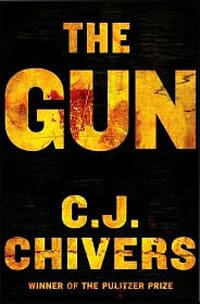To some people, history is a big, indigestible lump. When you consider that “history” can be loosely defined as “everything that happened to everyone, everywhere, since the beginning of time” it’s easy to understand why that is. As a result, there are several methods for studying history. You can classify it by subject, you can separate it by country, language or ethnicity, and you can separate it by eras, decades or centuries. You can also examine history by focusing on the people who made history. (It’s been said that “History is the biography of great men.”) Or, you can take a snapshot of history like C.J. Chivers in “The Gun”; examining history through the lens (or if you prefer, the front sight) of a specific piece of technology. In this case, the AK-47 rifle.
Chivers is a senior writer for the New York Times, a Pulitzer Prize winning war correspondent, and a former Marine captain. He’s crafted a comprehensive history not just of the AK-47, but of the evolution of automatic weaponry from the early 19th century through the present. The book is divided into three parts.
The first third of the book provides a detailed history of the birth of automatic weaponry in the early 1800’s. Two prominent characters loom large in this section, characters whose names were attached to the most prominent automatic weapons of that century: Dr. Richard Gatling, and Hiram Maxim.
In Chivers’ account, Gatling comes across as a somewhat naive physician, a man who saw the carnage of the Civil War and who thought that machine guns would obviate the need for mass armies, resulting in fewer dead sons and husbands. Maxim, by contrast, appears as a slick, amoral businessman whose only concern regarding his deadly weapons was how quickly they could propel him towards the wealth and fame he desired.
This chapter ends with the brutal slaughter of the First World War, and how it completely changed the way military forces approached the concept of automatic firearms.
The second part is a dual biography: Mikhail Kalashnikov, the wounded Red army NCO who invented the world’s most infamous firearm, and the firearm itself. Chivers examines post-Cold-war archives not available to previous AK researchers, and examines the way Kalashnikov’s invention acheived mythic status within the Soviet Union.
The first minor criticism of Chivers’ book is that author dwells on the many inconsistencies in Kalashnikov’s bio, and the fanciful accounts of the AK-47’s invention that became propaganda fare for the post-WWII Soviet Union. Any biography examined in any kind of detail is bound to reveal inconsistencies, contradictions or outright fabrications. Human memories are flawed, and are driven by human egos, which have needs like any other living organism. To quote the line from John Ford’s classic Western The Man Who Shot Liberty Valance, “When legend becomes truth, print the legend.”
Obviously the story of Kalashnikov and the AK assumed legendary status decades ago. This was particularly in the Soviet Union. Devastated by war and wracked by economic uncertainty, the3 country badly needed uplifting legends. Kalashnikov is neither the first nor the worst offender when it comes to resume padding or legend building. Chivers’ nitpicking of the details seems somewhat petty.
Nevertheless, Chivers’ extremely thorough account of the methodical processes by which the AK 47 was adopted are fascinating. Chivers details “the Breakout” and explains why the AK 47, driven by Soviet paranoia and the needs of a command economy to produce mass quantities of goods, became the world’s most ubiquitous firearm.
The third section, entitled “Aftermath” begins with a chapter called “The Accidental Rifle.” It’s a scathing indictment of the government/industrial collusion and military incompetence that resulted in the disastrous fielding of the M-16 rifle. Much of this is well known (problems with ammunition, Colt’s resistance to chroming bores). Chivers shows the back-door deals, the greased palms, and the deaf ears that were the cause of the M-16’s catastrophic introduction to combat in Vietnam.
It’s not a pretty story, but it’s one that needs to be told. It also provides a stark contrast to the methodical and undramatic procedures that created the Kalashnikov.
The final chapter, “Everyman’s gun”, expands on the “breakout” chapter. It illustrates how the AK, freed from the tenuous restrictions of the bi-polar Cold War world, has spread to every corner of the globe to become the preferred weapon of warriors, terrorists, criminals and governments.
Chivers spends many pages dwelling on the pain, suffering and death brought about by the AK. In some places, he seems to lay the blame for much of the world’s carnage at Mikhail Kalashnikov’s feet. But Chivers himself pointed out that Mihkail Kalashnikov was not the one-man weapons lab that Soviet myths made him out to be. The AK design was evolutionary, rather than revolutionary (every single feature of the AK had appeared in other weapons before Kalashnikov sat down to design his rifle). The AK-47’s popularity sprung from factors totally unrelated to the weapon itself.
If Mikhail Kalashnikov had never been born, if he had died from his wounds in 1941 or chosen to pursue another calling, something like the AK would still have been created. It might have looked a bit different or worked in a different way, but the factors that cause the AK to be built, the factors that caused it to be copied, distributed, stockpiled and ultimately sold – those factors would still have existed. And the lives lost or changed forever by the AK would have been just as lost or just as changed if the Soviet “Avtomat” had borne the name of another inventor.
Those are minor quibbles. “The Gun” is well-written, exhaustively researched and easy to read. I’ve added it to my library. History and firearms buffs will be glad to add it to theirs.





I am 3/4 the way through this. The comparison of how the AK47 and M-16 were conceived almost makes you ill. What a page turner!..I barely have time to read TTAG!
It’s hard to put down. I wouldn’t have thought a book about a gun could be so well put together.
Fantastic book, reading it now.
I’m reading it now. It is a worthwhile book and I like some of what it has to say and am disappointed by its organizational structure:
It gives some explanation to the difference between submachine, assault, and more traditional rifles issued to the foot soldier.
It gives some background to the Soviet mind-set as what Communish was begins to be lost to history.
But I think the book could have been shorter and yet have included more. Should have spent less print on Gatling and Maxim, shown more the evolution of guns (Didn’t mention the U Ss revolutionary M-1 in temporal context and gave short shrift to the real inventors of the assault rifle, the Germans, and kind of spot landed on what it wanted to give real depth to at the expense of breadth and context.
I wanted to read all that was in the book, but I also wanted to see more mechanical drawings of guns and ammunition and factories and location shots.
In brief: This book, while good, ‘told’ too much and ‘showed’ too little.
Comments are closed.